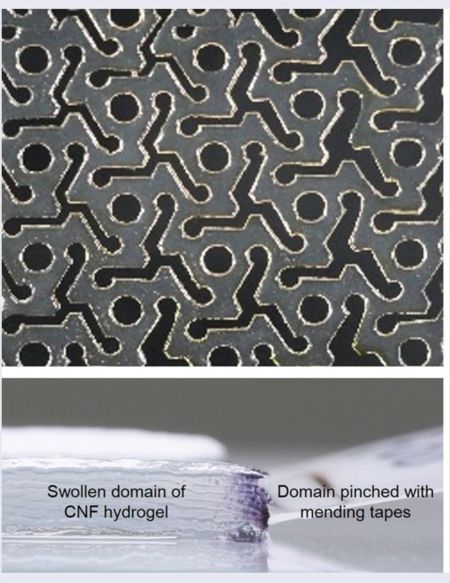
TSUKUBA, Japan, Apr 12, 2024 - (ACN Newswire) - New options for making finely structured soft, flexible and expandable materials called hydrogels have been developed by researchers at Tokyo University of Agriculture and Technology (TUAT). Their work extends the emerging field of ‘kirigami hydrogels’, in which patterns are cut into a thin film allowing it to later swell into complex hydrogel structures. The research is published in the journal Science and Technology of Advanced Materials.

Hydrogels have a network of water-attracting (hydrophilic) molecules, allowing their structure to swell substantially when exposed to water that becomes incorporated within the molecular network. Researchers Daisuke Nakagawa and Itsuo Hanasaki worked with an initially dry film composed of nanofibers of cellulose, the natural material that forms much of the structure of plant cell walls.
They used laser processing to cut structures into the film before water was added allowing the film to swell. The particular design of the Kirigami pattern works in such a way that the width increases when stretched in the longitudinal direction, which is called the auxetic property. This auxetic property emerges provided that the thickness grows sufficiently when the original thin film is wet.
“As Kirigami literally means the cut design of papers, it was originally intended for thin sheet structures. On the other hand, our two-dimensional auxetic mechanism manifests when the thickness of the sheet is sufficient, and this three dimensionality of the hydrogel structure emerges by swelling when it is used. It is convenient to store it in the dry state before use, rather than keeping the same water content level of the hydrogel.” says Hanasaki. “Furthermore, the auxeticity is maintained during the cyclic loading that causes the adaptive deformation of the hydrogel to reach another structural state. It will be important for the design of intelligent materials.”
Potential applications for the adaptive hydrogels include soft components of robotic technologies, allowing them to respond flexibly when interacting with objects they are manipulating, for example. They might also be incorporated into soft switches and sensor components. Hydrogels are also being explored for medical applications, including tissue engineering, wound dressings, drug delivery systems and materials that can adapt flexibly to movement and growth. The advance in kirigami hydrogels achieved by the TUAT team significantly extends the options for future hydrogel applications.
“Keeping the designed characteristics while showing adaptivity to the environmental condition is advantageous for the development of multifunctionality,” Hanasaki concludes.
Further information
Itsuo Hanasaki
Tokyo University of Agriculture and Technology
Email: hanasaki@cc.tuat.ac.jp
Paper: https://doi.org/10.1080/14686996.2024.2331959
About Science and Technology of Advanced Materials (STAM)
Open access journal STAM publishes outstanding research articles across all aspects of materials science, including functional and structural materials, theoretical analyses, and properties of materials. https://www.tandfonline.com/STAM
Dr Yasufumi Nakamichi
STAM Publishing Director
Email: NAKAMICHI.Yasufumi@nims.go.jp
Press release distributed by Asia Research News for Science and Technology of Advanced Materials.
Copyright 2024 ACN Newswire. All rights reserved. www.acnnewswire.com































